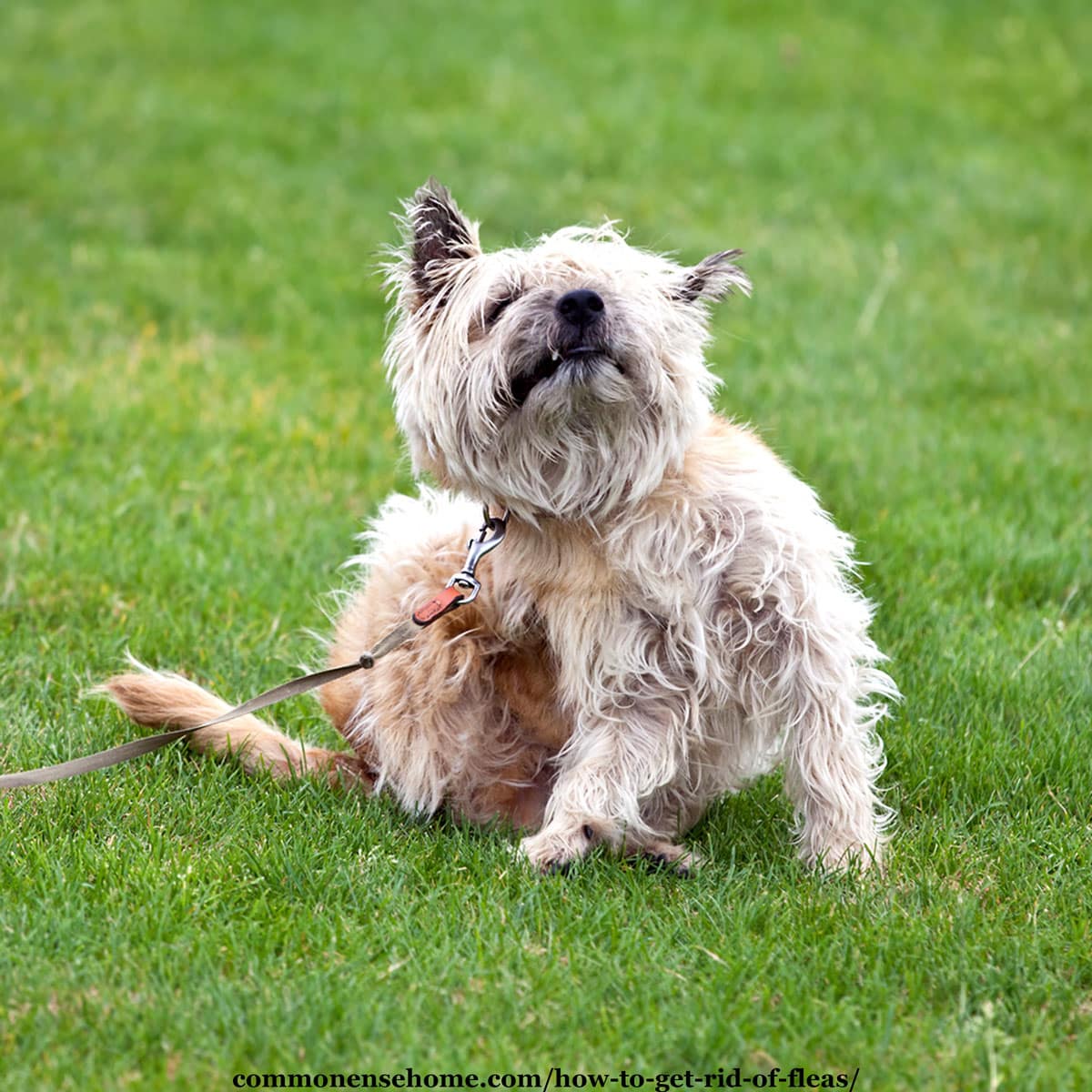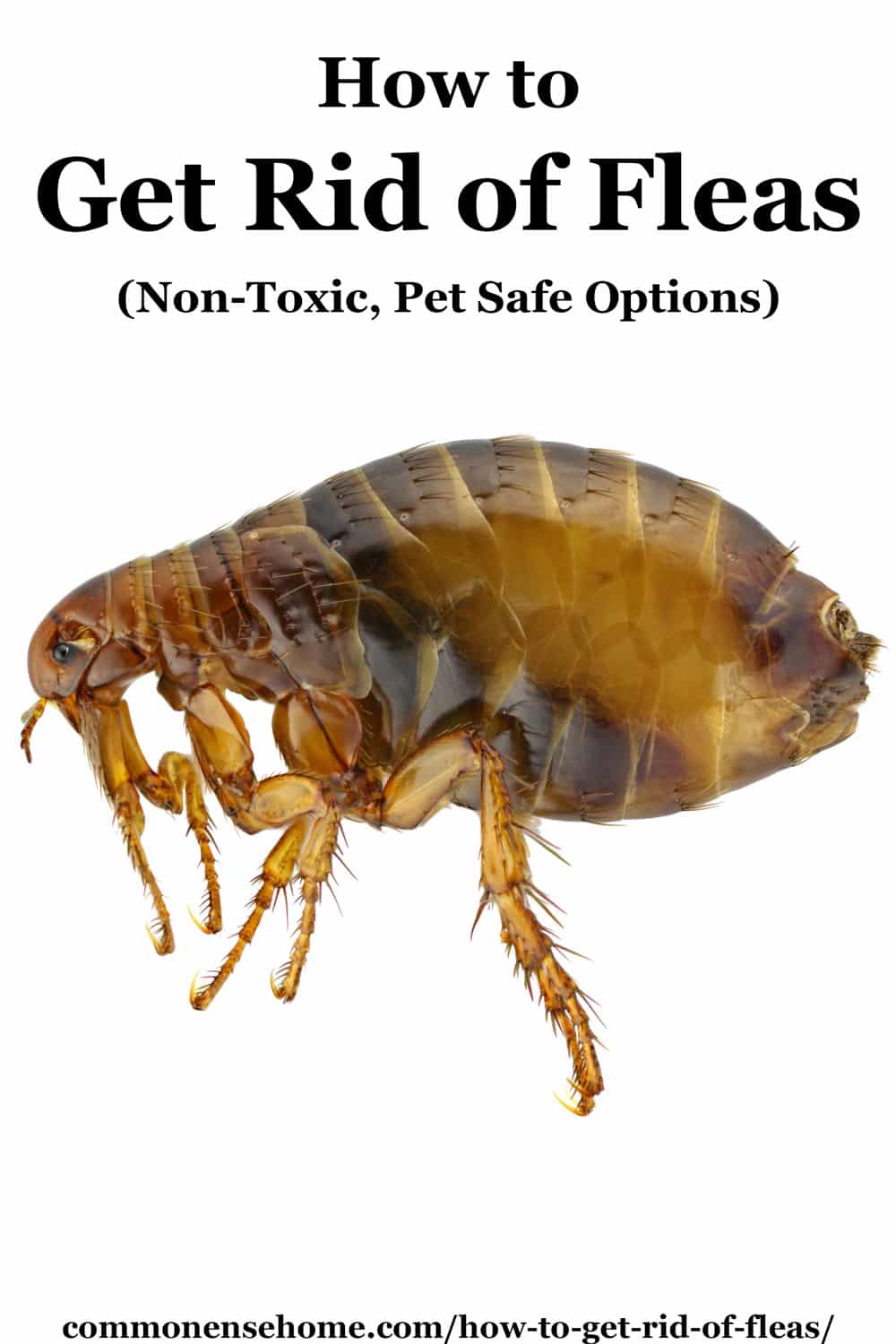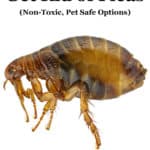How to Get Rid of Fleas (Non-Toxic, Pet Safe Options)
This post may contain affiliate links. Read my full disclosure here.
If you have pets, at some point you’ll likely have fleas. Most commercial flea treatments are toxic and expensive. We’ll discuss how fleas affect pets and people, the flea life cycle, and how to use non-toxic methods to get rid of fleas.

The Danger of Fleas
Fleas are a nuisance. Even if they aren’t biting your ankles, hearing your poor pets scratch endlessly is enough to drive you crazy.
Some flea bite symptoms include:
- Itching and discomfort, both to humans and fur babies
- Pets and humans can be allergic to fleas and develop skin issues such as flea-bite dermatitis
- Fleas drink your pet’s blood, which can lead to anemia
- Fleas can carry tapeworms. When your pet licks themselves, they may ingest the fleas and get parasites. (Our two puppies got tapeworms twice last year from fleas. I’ve seen other dogs near-death due to anemia from flea infestation.)
Flea Bites on People
Pet owners are not the only ones who deal with fleas.
I remember when we first moved into our beach house, and I was so excited to have my own yard again. Then it started – little red dots on my ankles, slight twinges of pain followed by itching.
Fleas in your yard can travel on rodents, wildlife, or on the pant legs of visitors.
Some of the sicknesses and diseases that can be transmitted by fleas to humans are: (source)
- Allergic Reactions
- Bubonic plague
- Tularemia
- Tungiasis
- Murine typhus
Thankfully, most of these are rare, but it’s best to get rid of fleas and the risk.
Flea Life Cycle
Once you understand the life cycle of a flea, you can begin your plan of attack to get rid of them.
Fleas go from egg to larva to pupa, before the final adult stage. The entire process can take anywhere from two-three weeks to several months, depending on the conditions.
Adult fleas can live up to one year in an ideal situation, but will only survive about one to two weeks if no host is present.
Fleas can begin laying eggs after their first blood meal and can lay up to 50 eggs per day.
A flea egg will hatch in the right conditions within the first 36 hours. If the conditions aren’t favorable, it can take up to six days for an egg to hatch.
Favorable conditions are warm and high humidity. If temperatures are cold and dry, the eggs will take longer to hatch.
If the humidity is lower than 50% and the temps are higher than 95 degrees, the larvae will die once hatched.

Commercial Flea Medicine Can Be Toxic To Pets
There have been an increasing number of reports of illness from commercial flea medicines, including but not limited to:
- being off color
- twitching
- hives
- excessive salivation
- vomiting
- diarrhea
- loss of coordination
- convulsions
- seizures
- death
You can read the CDC Report here.
I firmly believe that using the flea medicines I received from my vet played a massive role in the declining health and death of my dog, so I no longer use them.
How to Get Rid of Fleas
Regular flea treatment and repellents, combined with good hygiene, keep flea populations under control.
Use the flea life cycle to plan your flea control. If you treated for fleas and there were eggs you missed, you will need to treat again in two days, 6 days, and two weeks.
Important Note: There is no natural magic cure that will kill all the fleas with just one treatment. You are in this for the long run.
We are programmed by the commercial industry to rely on “instant” results. These results often come at the cost of sick pets.
If a natural approach doesn’t seem to be working, try another, or check to see if you can adjust what you’re doing so it works better.
What Eats Fleas?
Since we’ve had chickens and guineas, I’ve seen a drastic decrease in the insect and flea population. You can read more about natural tick control here.
While other animals and wildlife will eat fleas, the list below are your best options to help get rid of fleas.
- Chickens
- Snakes
- Guineas
- Frogs
- Opossums
- Ants
- Beneficial Nematodes. Beneficial nematodes are great to add to your yard to consume the flea larvae. Make sure you purchase beneficial nematodes and not regular nematodes.
All Natural Flea Repellent
This natural flea repellent powder works against fleas by dehydrating them and repelling them. (Remember how fleas need moist conditions to thrive?)
Please exercise caution when using this repellent. Do not include the cedar essential oil when treating cats, unless you use a formulation that is marked cat safe.
Would you like to save this?
- Always make sure to use in a well-ventilated area.
- Keep away from your pet’s nose and mouth when applying.
- Do not inhale the powder as it can cause respiratory issues.
- Apply the powder dry and make sure there is no draft or wind.
Ingredients
- 1/2 Cup of Food Grade Diatomaceous Earth (Buy diatomaceous earth online)
- 1/4 Cup Powdered Catnip (Buy catnip powder online.)
- 1/4 Cup Neem Powder (Buy neem online)
- 10 Drops Cedar Essential Oil (FOR DOGS ONLY) (Buy cedar essential oil online)
Directions
- Place all ingredients in a sealed jar and shake until well blended.
- Keep in a sealed container until needed.
- Shake powder in hand and apply liberally from the shoulder to the tail and from the chest to the groin.
How To Get Rid of Fleas in the House
If you want to get a handle on your flea problem, you need to apply the trifecta of flea treatment. That means treating fleas in your home, yard, and on your pets at the same time.
For example, when I go to give my dogs a flea bath and treatment, I also wash their bedding and vacuum the house. I repeat this at two days, six days, two weeks and thirty days.
Vacuum
A vacuum is your friend when it comes to your battle against fleas. Vacuum often and thoroughly. Pretend you’re looking for a lost diamond earring–lift every cushion, every piece of furniture, and go under bedding.
Once you’ve vacuumed the entire house, place the vacuum bag into a trash bag (or empty the vacuum bin into a bag). Tie a knot in the bag and take the trash out of the house.
Wash Everything
Wash everything your cat or dog lays on in your home, including their bedding, in hot water. Make sure you dry the items on high heat, as some fleas will survive the initial bath.
When you wash your pet, use warm soapy water mixed with vinegar and pet safe shampoo. Rinse well and dry. Wash towels in hot water. Use a flea comb to help remove fleas and larva.
Turn On A Nightlight
This works wonders for us. When we perform “operation flea extermination”, we place a bowl of water right by where our dogs sleep, or anywhere we notice fleas.
Add a couple drops of dish soap to the water and place a desk lamp right over the bowl of water. Turn off all the other lights in the room and leave the one light over the bowl on all night.
You will be shocked, and a little grossed out, at how many fleas decided to go for a swim at night.
Dump the bowl daily, and repeat until you have gone two weeks without any sign of new swimmers.
Herbs That Repel Fleas
Herbs are wonderful for repelling spiders, ticks, mosquitoes, and even treating bites and stings. It’s only natural that they would be effective in repelling fleas as well.
You can use these herbs to help repel fleas by planting them all around your yard. You can make flea pillows and place them in your pet’s bedding, or make a flea repellent like we did in the recipe above.
Here is a list of some common herbs that help repel fleas.
- Catnip
- Yarrow
- Cedar*
- Mint
- Sage
- Fleabane*
- Rosemary
- Pennyroyal*
- Lemongrass
- Rue*
- Eucalyptus*
* Do not use cedar with cats, do not use fleabane, pennyroyal, rue or eucalyptus where a pet might eat them.
The Key To A Flea Free Pet
One of the most significant discoveries in the flea battle is that there is a direct correlation between a pet’s health and their ability to resist fleas Healthy dogs seem to have the ability to repel flea infestations.
I have littermate miniature dogs, both girls. One is healthy and big, whereas the other is the runt. I’ve noticed that the runt is more prone to fleas than her older, healthier sister. They both have identical lives, yet the runt gets fleas and her sister doesn’t?
Supplements have been known to help dogs and pets too, such as garlic, apple cider vinegar, probiotics, and brewers yeast.
Vets of dogs on natural diets have noticed a decrease in flea activity. Although I don’t give our pets a raw food diet, I support the premise behind it and I would love to transition our animals to a raw food diet in the future.
There is no way to get rid of fleas completely, but you clear them out of your home and off your pets.
Have you used a natural flea remedy that worked? We would love to hear your results.

More Non-Toxic Pest Control Options
We have a number of non-toxic pest control articles on the website, including:
- Natural Mosquito Repellents That Work
- 9 Tips to Get Rid of Fruit Flies, Plus the Best Homemade Fruit Fly Trap
- The Best Ways to Get Rid of Mice in Your House and Garage
- How to Get Rid of Ants Naturally
- Deer Fly Control and Deterrent Tips to Keep Biting Flies Away

This post is by Amber Bradshaw of My Homestead Life.
Amber and her family moved from their tiny homestead by the ocean in South Carolina to forty-six acres in the Smoky Mountains in East Tennessee.
They cook without electricity, collect water from the creek and raise chickens, goats, pigs, turkeys, bees, and guineas.
They filmed their journey for a TV show called Building Off The Grid: The Smokey Mountain Homestead.



Did ya’ll check to make sure the cedar essential oil is safe for cats? I know a lot of oils are not, and I’m not sure which ones. Just wanted to make sure that had been checked before recommending for cats . . .
Hi Elaine.
As noted in the post, I don’t include the cedar essential oil when treating cats. I just bolded that text to make it stand out more.
I successfully got rid of fleas in my house (6 cats) with the following DIY recipe:
DIY FLEA & TICK POWDER
FOR CATS AND DOGS
INGREDIENTS
• 1/2 cup diatomaceous earth, FOOD GRADE
• 2 Tbsp. lavender buds, finely ground
• 3 Tbsp. neem leaf, finely ground
• 3 Tbsp. yarrow, finely ground
• 5 drops lemongrass essential oil or catnip oil
• 5 drops Virginia cedarwood essential oil
• 5 drops lavender essential oil
DIRECTIONS
1. Wearing a mask to prevent breathing in the dust, gently whisk together diatomaceous earth and finely ground herbs in a bowl.
2. If adding essential oils (for DOGS only), wearing gloves add essential oil drops to the powder mix and gently break up all of the clumps, using your gloved hands.
3. Store in a jar with a shaker lid. This mix will last up to a year or longer as long as no water gets into the jar.
However, because I have cats, I ONLY used this powder on all the surfaces inside the home I vacuumed, letting the powder sit for at least 15 minutes before I vacuumed it up. On my cats, I just used a little DE which I put on my hands and then rubbed on them from behind the ears down thru the tail, and on their underside, especially the back legs. I also added garlic powder and brewers yeast to their food every other day, garlic being something you need to be sure you know how to dose before giving it to a cat. (Garlic makes an animal very distasteful to a flea.) I’m a Nutritional Therapy Practitioner, and I always do a lot of research before applying any remedy…to either human or animal!
Michelle, for the herbs, where it says finely ground. Can that be powder? Or does it need to be the actual dried herb ground small (but not powdered)? Or does it matter? Thanks!
I would think powdered would work just fine.
I forgot to write about one more remedy for fleas and lice for our pets. Cloves, you just need to grind them – cloves and put them in the animal bath. However, we can stick whole cloves to our puppy’s collar. Four at equal intervals. The strong scent of cloves will effectively scare away insects.
Bathing in turmenic ginger I with rock or Himalayan salt also helps to fight fleas. However, as you wrote in your article, a bath helps – a regular weekly bath and washing the dog’s bed.
What proportions of ingredients do you use in a bath, or is there a prepackaged product with that mix?
When I bathed my dog in it, it was 10 liters of water and a tablespoon of turmenic, ginger and rock salt (with minerals). When I bathed my pigeon in it, it was 5 liters of water and one and a half teaspoons of herbs. This is my personal proportion. It is effective, but the plumage / hair changes color as well. Of the white pigeon, I had an overgrown canary bird at home. 😀
Thanks, Bernardette. I had wondered about that, too, since turmeric likes to stain.
At this point, it doesn’t matter that it stains. It is important that our pet will be cleaned using healthy methods, not chemicals. Anyway, people have a crazy penchant for dressing up their beloved pets, so at this point, a slightly different view of your beloved pet for your next regular bath won’t hurt. It will even give you a few days of fun and joy. Turmenic will come down during the next baths, because it is a natural remedy. My pigeon washed it off by itself. Ah, I forgot to add before that of course you have to rub this mixture with a brush. Further baths can be repeated every week. So there will be 3 of them together. After all, our pet’s appearance will return to normal.
I’m with you. I’d rather have temporary stains than permanent nerve damage like some of the nasty commercial stuff.
Do you mean cedarwood essential oil?
Yes, cedar or cedarwood. Some companies specifically refine their oils to remove the compounds that are a problem for cats. Some varieties are cedar are potentially more problematic than others.
Our yard stays wet year round. And the fleas in our area are resistant to many of the less expensivce OTC remedies. We fight them yearly, an ended up with the Soresto collar with good results. But we will see how long that works. In the meantime, some of the things we tried with some effectiveness were:
Bathing with Dawn Original blue dish soap
Bathing with Murphys Oil Soap
DE on the carpets (;et it set a while before vacuuming, and it does need repeated as the article mentions)
ACV in the dog’s drinking water (helps with a lot of pests)
We also tried applying DE in the yard, but it has to be reapplied after every rain, and with our yard staying so wet,IDK if it helped at all, plus I was worried about how it would affect beneficials.
We also tried EO’s on the collar, like lemongrass and ‘propirietary blends’, but didn’t find that very helpful.
Hope these additional tips might help!
Thanks!
In spite of all the deer running around, we don’t have much flea pressure here, so I don’t have the opportunity for testing like you and Amber do.
Very good. Thank you.
You’re welcome.